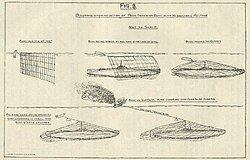129:, Japanese midget submarines were able to enter the inner harbor via an open gate and avoid the submarine nets. The standard submarine net at Pearl Harbor consisted of 300 foot panels of 1 inch mesh rope with 8 foot diagonal openings. The midget submarines were designed to penetrate this type of net with features including a small size, net cutters and a tail with no projections which would snag the net. After the attack, a light
20:
120:
was entangled in one of the nets. The captain surfaced in an attempt to cut the net free and the surfaced submarine was subjected to ineffectual gunfire from the fishing boats. The submarine was scuttled as its propellers had been fouled by the net and escape was impossible. All the crew were
105:
The
British also used indicator nets attached to converted fishing boats. The boats were armed with guns and depth charges to attack any submarine that became entangled in their net. A number of these boats were deployed in the Mediterranean as part of the
124:
The
British continued to develop indicator nets between World Wars I and II, though the Americans did not. In 1939, the British shared their expertise with the United States Navy. Before and during the
271:
315:
92:
attached to the net drifted along the water's surface indicating an enemy below. The first example of indicator nets causing the destruction of a U-boat occurred at
296:
66:
as a means of discouraging enemy submarines from entering Allied waters, indicator nets were used extensively during
320:
207:
153:
141:
73:
Instead of being used as the sole anti-submarine measure, indicator nets were often mixed with extensive
276:
Pearl Harbor Attack: Hearings Before the Joint
Committee on the Investigation of the Pearl Harbor Attack
137:
115:
126:
23:
Diagram showing the operation of an indicator net. The entanglement of the submarine causes a
270:
8:
199:
The Battle of the
Otranto Straits: Controlling the Gateway to the Adriatic in World War I
249:
203:
111:
275:
245:
197:
174:
107:
70:. Individual nets were sometimes as much as 100 metres (330 ft) in length.
85:
were attached directly to the nets, thus reducing submarine survival chances.
309:
144:
has brought indicator nets back into consideration as a defensive strategy.
55:
often managed to disentangle themselves and escape before being blown up by
56:
67:
82:
63:
44:
74:
52:
43:
were often anchored at various depths to the sea bed around Allied
78:
297:
Ukrainian ingenuity is ushering in a new form of warfare at sea
272:
Joint
Committee on the Investigation of the Pearl Harbor Attack
97:
48:
19:
93:
36:
24:
172:
89:
28:
88:
After a submarine became entangled in the net, a marker
31:
47:
during both world wars. They were intended to entangle
316:
World War II military equipment of the United
Kingdom
114:. On 12 May 1917, the Austro-Hungarian submarine
307:
246:U. S. Navy Bureau of Ordnance in World War II
195:
243:
244:Rowland, Buford; Boyd, William B. (1953).
18:
136:In the 21st century, the rising use of
308:
239:
237:
235:
51:traffic of the enemy, even though the
173:Office of Naval Intelligence (1916).
232:
102:became entangled on March 4, 1915.
13:
14:
332:
175:Notes on Anti-Submarine Defenses
290:
264:
223:
189:
166:
133:was deployed at Pearl Harbor.
62:Predominantly deployed by the
1:
159:
154:Anti-submarine indicator loop
16:Nets used to entangle U-boats
202:. Indiana University Press.
142:unmanned underwater vehicles
27:to automatically light on a
7:
299:, The Economist, 7 Dec 2022
147:
10:
337:
138:unmanned surface vehicles
35:Constructed using light
321:Anti-submarine warfare
196:Halpern, Paul (2004).
127:attack on Pearl Harbor
32:
22:
229:Halpern (2004), p.37
252:. pp. 172–185
250:Bureau of Ordnance
33:
112:Strait of Otranto
328:
300:
294:
288:
287:
285:
283:
268:
262:
261:
259:
257:
241:
230:
227:
221:
220:
218:
216:
193:
187:
186:
184:
182:
170:
336:
335:
331:
330:
329:
327:
326:
325:
306:
305:
304:
303:
295:
291:
281:
279:
269:
265:
255:
253:
242:
233:
228:
224:
214:
212:
210:
194:
190:
180:
178:
171:
167:
162:
150:
110:, to block the
108:Otranto Barrage
77:and patrolling
17:
12:
11:
5:
334:
324:
323:
318:
302:
301:
289:
263:
231:
222:
208:
188:
164:
163:
161:
158:
157:
156:
149:
146:
41:indicator nets
15:
9:
6:
4:
3:
2:
333:
322:
319:
317:
314:
313:
311:
298:
293:
277:
273:
267:
251:
247:
240:
238:
236:
226:
211:
205:
201:
200:
192:
176:
169:
165:
155:
152:
151:
145:
143:
139:
134:
132:
131:indicator net
128:
122:
119:
118:
113:
109:
103:
101:
100:
95:
91:
86:
84:
80:
76:
71:
69:
65:
60:
58:
57:depth charges
54:
50:
46:
42:
38:
30:
26:
21:
292:
280:. Retrieved
266:
254:. Retrieved
225:
213:. Retrieved
198:
191:
179:. Retrieved
168:
135:
130:
123:
116:
104:
98:
87:
81:. Sometimes
72:
61:
40:
34:
68:World War I
45:naval bases
310:Categories
282:January 2,
256:January 2,
248:(Report).
215:January 2,
209:025311019X
181:January 2,
160:References
75:minefields
64:Royal Navy
53:submarines
121:rescued.
96:when the
278:(Report)
177:(Report)
148:See also
79:warships
206:
117:SM U-6
49:U-boat
39:nets,
94:Dover
83:mines
37:steel
25:flare
284:2020
258:2020
217:2020
204:ISBN
183:2020
140:and
90:buoy
29:buoy
99:U-8
312::
274:.
234:^
59:.
286:.
260:.
219:.
185:.
Text is available under the Creative Commons Attribution-ShareAlike License. Additional terms may apply.
